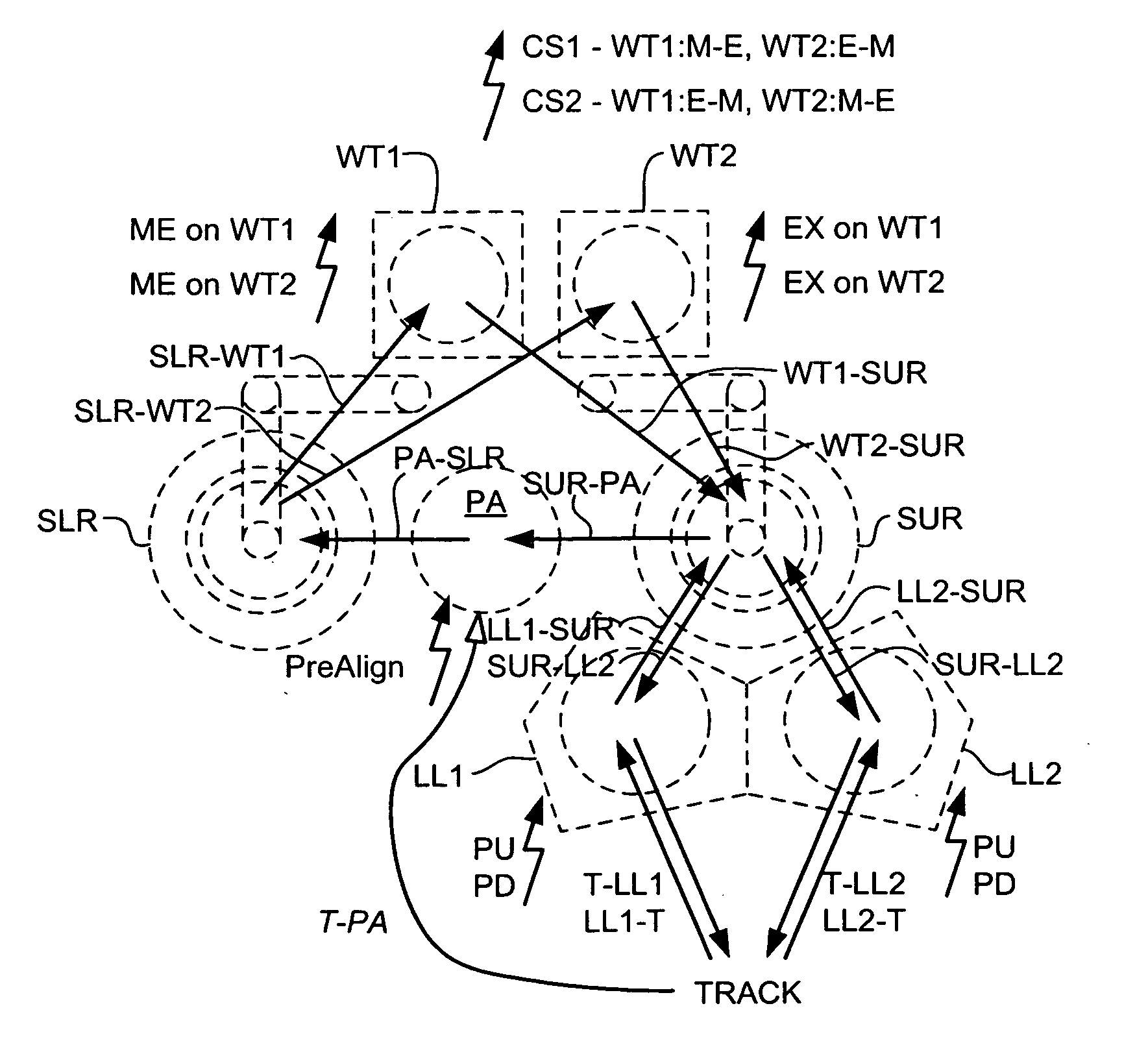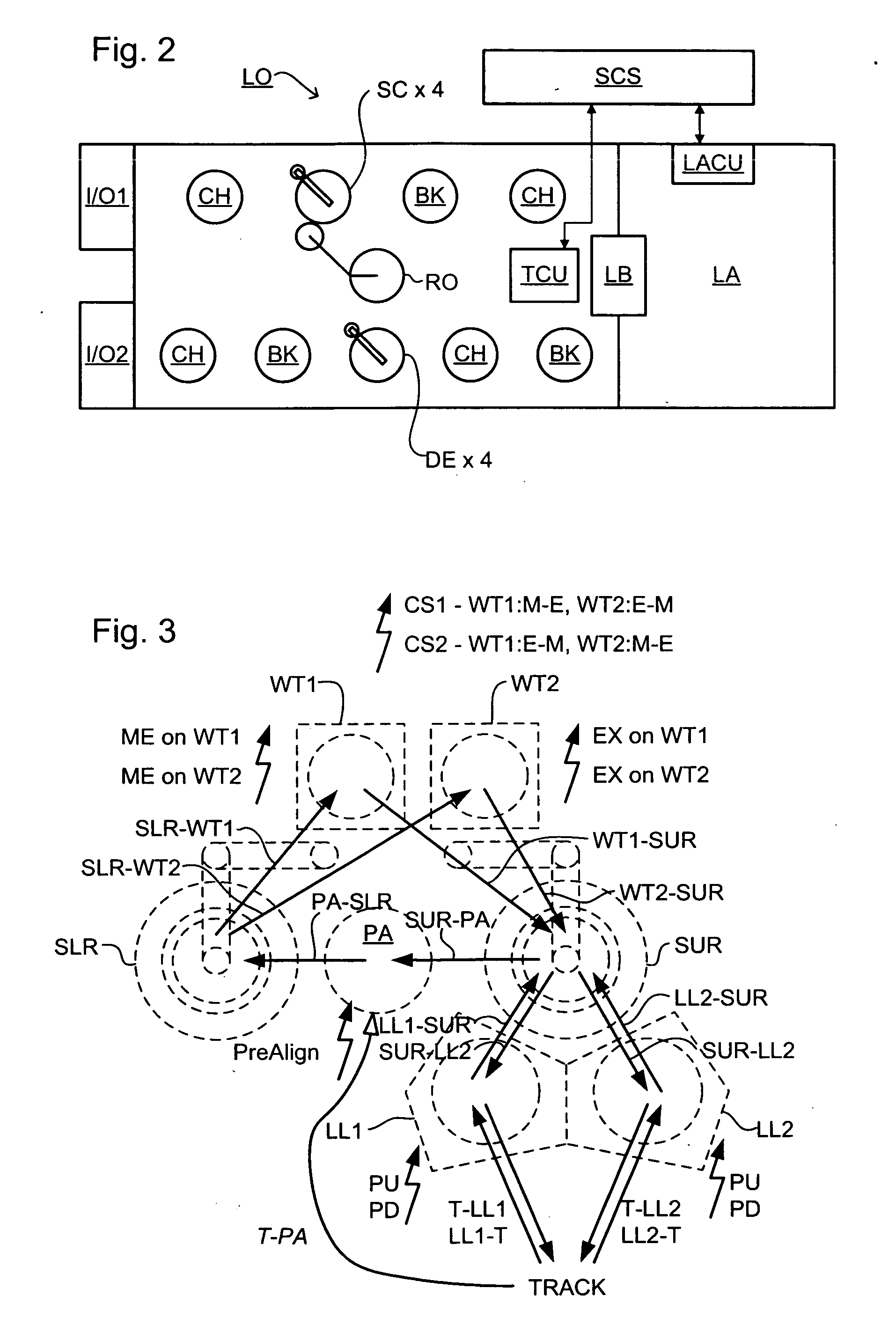Method of operating a lithographic processing machine, control system, lithographic apparatus, lithographic processing cell, and computer program
a technology of lithographic processing machine and control system, applied in the direction of program control, total factory control, therapy, etc., can solve the problems of complex task, limited on-the-fly scheduling, and optimizing the schedul
- Summary
- Abstract
- Description
- Claims
- Application Information
AI Technical Summary
Benefits of technology
Problems solved by technology
Method used
Image
Examples
example 1
Plane Positioning
[0219] We consider a plane nearly parallel to the XY plane of a coordinate system with base α=({right arrow over (α)}x,{right arrow over (α)}y,{right arrow over (α)}z) and origin Oα (see FIG. 25). A sensor is available to measure the height (z) of points on the plane. We derive the following linear relation of the parameters involved in the height measurement:
sspα=szoα+Rysxpα+Rxsypα (18)
[0220] We can rewrite this in the form of (16) as follows:
ss0α+Rysxpα+Rssypα−sxpα=0 (19)
[0221] Suppose that the sensor can measure at three different positions in the XY-plane: (szpα,sypα)=(1,0),(0,1), and (1,1) (see FIG. 25). Instantiating the three positions in (19) yields: [110-1001010-1011100-1][sz0αRyRxsz1αsz2αsz3α]=0(20)
[0222] Using m equations from a linear .system such as equation (17) it is possible to derive r unknown parameters. Here r denotes the rank of the coefficient matrix for the m equations, i.e. the number of linearly independent parameters. If more than r...
example 2
Combining Parameters
[0224] Suppose we can measure the plane height at two positions s4α(x, y)=(−1,−1) and s5α(x, y)=(1,1) yielding sz4α and sz5α. Then, the system describing the parameter relations yields: [1-11111][sz0αRyRx]=[sz4αsz5α](22)
[0225] The rank of the coefficient matrix indicates that we can only solve equation (22) for two parameters. Therefore, we define a combined parameter
Rxy=Rx+Ry, (23)
and substitute this combined parameter into (22) to obtain the following system with full rank: [1-111][sz0αRxy]=[sz4αsz5α](24)
[0226] Now, the tilt of the plane can be determined versus the line x=y. Adding Equations (23, 24) to (22) results in the following system of geometric relations: [1-1-10-1011100-1011-100100-1-1010010-1][sz0αRxRyRxysz4αsz5α]=0(25)
[0227] We define an estimate {tilde over (x)} of parameter x with error Δx as follows:
{tilde over (x)}≡x+Δx (26)
[0228] In certain circumstances, it is allowed to assume that the parameter coefficients can be estimated acc...
example 3
Sensor Inaccuracies
[0234] In the plane positioning example, we measure the height szpα of a point p in the plane with a certain inaccuracy βp. Adding the sensor inaccuracies for the two measurements yields the following system: [1-1-10-1011100-1011-100100-1-1010010-1000010000001][sz0αRyRxRxysz4αsz5α]=[00000β4β5](31)
[0235] Now, the parameter vector contains parameter inaccuracies. The vector of known constants contains both known constant inaccuracies (all zero in this example) and sensor inaccuracies.
[0236] We have deducted the linear parameter relations for the CS and IS measurements in the mask stage alignment case from the vector relations depicted in FIG. 24A. This deduction involves considering a zeroing error, a lens-to-stage offset and the vector coordinates transformation as depicted in FIG. 26 for the XZ plane. Symbols used in this figure include the following: [0237] Metro Frame coordinate system or wafer stage zeroing coordinate system (WZ_CS) with base ε=({right arro...
PUM
| Property | Measurement | Unit |
|---|---|---|
| end time | aaaaa | aaaaa |
| wavelength | aaaaa | aaaaa |
| wavelength | aaaaa | aaaaa |
Abstract
Description
Claims
Application Information
 Login to View More
Login to View More - R&D
- Intellectual Property
- Life Sciences
- Materials
- Tech Scout
- Unparalleled Data Quality
- Higher Quality Content
- 60% Fewer Hallucinations
Browse by: Latest US Patents, China's latest patents, Technical Efficacy Thesaurus, Application Domain, Technology Topic, Popular Technical Reports.
© 2025 PatSnap. All rights reserved.Legal|Privacy policy|Modern Slavery Act Transparency Statement|Sitemap|About US| Contact US: help@patsnap.com



